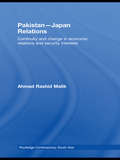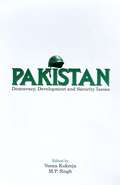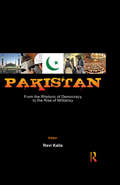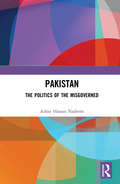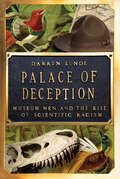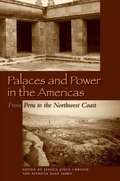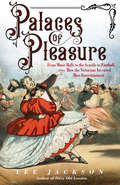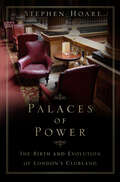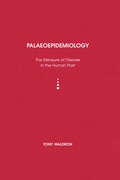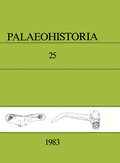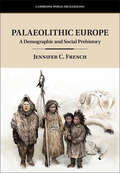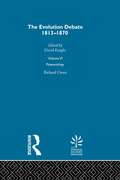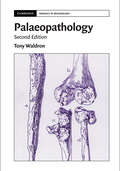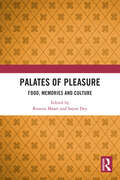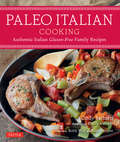- Table View
- List View
Pakistan-Japan Relations: Continuity and Change in Economic Relations and Security Interests (Routledge Contemporary South Asia Series)
by Ahmad Rashid MalikThis is the first book-length study to explain the complex nature of Pakistan-Japan relations. It analyses the evolution and development of relations between the two countries by defining two key factors: economic interests and security concerns in the US-led global security system. Providing a thorough analysis of the history of relations between the countries, the important role Pakistan played in the context of peace and conflict resolution in East Asia during 1947-52, which helped ending the Occupation of Japan and restoring the country’s post-war economy, is highlighted. Pakistan then emerged as the largest trading partner of Japan only after the United States. It was Pakistan’s benevolent role that helped Japan to comeback to Asia in the 1950s as the author explains these events in greater detail that are not commonly known. In the 1960s and also in the 1980s during the Soviet occupation of Afghanistan, Pakistan emerged as one of the largest recipients of Japanese aid. The author explains that Japanese strategic aid to Pakistan was diverted to strengthen democratic values and institutions after the end of the Cold War. He then clarifies that Pakistan-Japan relations were dominated by two main issues during the 1990s, Japanese economic cooperation in Pakistan's trade liberalization, and suspicion about Pakistan's nuclear program. In conclusion, the author states that there has been a remarkable continuity in the area of economic relations, though there have been changes in security concerns. The book sets out future prospects for economic and diplomatic relations between the two countries, and it will be of interest to academics working in the field of International Relations, International Political Economy, and Asian Studies. For intellectuals, diplomats, and businessmen, the book would be a handy reference.
Pakistan: Democracy, Development and Security Issues
by Veena Kukreja and M.P. SinghThis collection of essays takes a fresh look at the contentious themes of democracy, development and security in Pakistan today. Arguing that the three are closely interlinked, the editors posit that the political and economic experience of the past 58 years shows that neither democracy nor capitalist development can survive without the other. Using a variety of Pakistani, Indian and Western sources, the distinguished contributors examine the internal and external problems of Pakistan with an eye on the challenges that democracy has encountered in the country.
Pakistan: From The Rhetoric Of Democracy To The Rise Of Militancy
by Ravi KaliaThe essays in this volume address the central theme of Pakistan’s enduring, yet elusive, quest for democracy. The book charts Pakistan’s struggle from its very inception, at least in the political rhetoric provided by both civilian and military leaders, for democracy, liberalism, freedom of expression, inclusiveness of minorities and even secularism. At the same time, it demonstrates how in practice, the country has continued to drift towards increasingly brittle authoritarianism, religious extremism and intolerance of minorities — both Muslim and non-Muslim. This chasm between animated political rhetoric and grim political reality has baffled the world as much as Pakistanis themselves. In this volume, scholars and practitioners of statecraft from around the world have sought to explain the dichotomy that exists between the rhetoric and the reality. Crucial areas such as Pakistan’s troubled status as a theocracy; its relationship with the US; the position of women and their quest for empowerment; the Mujahir Qaumi movement; the sharp class divide that has led to an elitist political culture; and finally, an erudite discussion of the popular topic — Jinnah’s vision of Pakistan — are the focus of this book. This volume will be of interest to scholars of history, political science, international relations, sociology, anthropology and urban planning, policy-makers and think-tanks, as well as the wider reading public curious about South Asia.
Pakistan: The Politics of the Misgoverned
by Azhar Hassan NadeemThis book offers a comprehensive analysis of the state of political institutions, the military establishment and political parties in Pakistan. It provides a nuanced understanding of the practices of disenfranchisement by theocratic governments in the country which has relegated the people to the margins of their society. The volume provides an in-depth account of the political history of Pakistan focusing not only on national politics and foreign policy but also on their congruences with subnational systems of governance, the criminal justice system, bureaucracy, the electoral system and the police. It discusses challenging issues plaguing the country such as the continued dominance of the military, lagging economic development, lack of accountability within political institutions, sectarianism and terrorism. The author dissects and critically examines Pakistan’s hegemonic politics and underlines the need for a new social contract based on the principles of inclusiveness and equality. The volume offers fresh perspectives on the multifaceted problems in Pakistan’s politics. It will be of great interest to policy practitioners and to academics and students of politics, law and governance, sociology, international relations, comparative politics, Pakistan studies and South Asia studies.
Pakistan’s National Security Approach and Post-Cold War Security: Uneasy Co-existence (Routledge Studies in South Asian Politics)
by Arshad AliThis book analyzes the paradox that despite being a national security state, Pakistan has become even more insecure in the post-Cold War era. It provides an in-depth analysis of Pakistan’s foreign and security policies and their implications for the overall state and society. The book identifies the immediate security challenges to Pakistan and charts the distinctive evolution of Pakistan’s national security state in which the military elite became the dominant actor in the political sphere of government during and after the Cold War period. By examining the national security state, militarization, democracy and security, proxy wars and the hyper-military-industrial complex, the author illustrates how the vanguard role of the military created considerable structural, sociopolitical, economic, and security problems in Pakistan. Furthermore, the author argues that the mismatch between Pakistan’s national security stance and the transformed security environment has been facilitated and sustained by the embedded interests of the country’s military-industrial complex. A critical evaluation of the role of the military in the political affairs of the government and how it has created structural problems for Pakistan, this book will be of interest to academics in the field of South Asian Politics and Security, South Asian Foreign and Security Policy, International Relations, Asian Security, and Cold War Studies.
Pakistan’s Security and the India–US Strategic Partnership: Nuclear Politics and Security Competition (Routledge Studies in South Asian Politics)
by Syed Shahid BukhariThis book explores the relationship between the developing India–US strategic Partnership and Pakistan’s security. It assesses India and the US's areas of cooperation to show that the partnership will bring drastic changes for India’s military capabilities and modernization of its forces. The book shows that, in addition to enhancing India’s domestic nuclear stockpiles through the nuclear cooperation agreement, collaboration in high-tech areas such as space and innovative technologies will enable India to acquire sophisticated delivery systems as well as surveillance capacity. The author argues that these advancements will enable India to destabilize the strategic balance in the region. The book also briefly explores the nuclear doctrines of India and Pakistan that provide an insight into the role of nuclear weapons in maintaining deterrence in the region. To understand the power dynamics caused by the strategic partnership and their impact on strategic stability in South Asia, the author utilizes the Balance of Power and Power Transition theories. A timely analysis of the India–US Strategic Partnership with a Pakistan angle, the book will be of interest to academics working in the fields of Asian security, Asian politics, especially South Asia, strategic studies, international relations, political science, nuclear non-proliferation, conflict studies, arms control, and security studies.
Palace Politics
by Jonathan SchleferBringing rare interviews and meticulous research to the cloaked world of Mexican politics in the mid-twentieth century, Palace Politics provides a captivating look at the authoritarian Mexican state--one of the longest-lived regimes of its kind in recent history--as well as the origins of political instability itself, with revelations that can be applied to a variety of contemporary political situations around the globe. Culling a trove of remarkable firsthand accounts from former Mexican presidents, finance ministers, interior ministers, and other high officials from the 1950s through the 1980s, Jonathan Schlefer describes a world in which elite politics planted the seeds of a mammoth socioeconomic crisis. Palace Politics outlines the process by which political infighting among small rival factions of high officials drove Mexico to precarious situations at all levels of government. Schlefer also demonstrates how, earlier on, elite cooperation among these factions had helped sustain one of the most stable growth economies in Latin America, until all-or-nothing struggles began to tear the Mexican ruling party apart in the 1970s. A vivid, seamlessly narrated history, Palace Politics is essential reading for anyone seeking to better understand not only the nation next door but also the workings of elite politics in general.
Palace of Deception: Museum Men and the Rise of Scientific Racism
by Darrin LundeAn eye-opening look into the founding of the American Museum of Natural History and its original racial underpinnings. From 1908 to 1933, the American Museum of Natural History launched more scientific field expeditions than at any other time in its existence. Sponsoring lavish trips to Africa and Central Asia, the museum filled its halls with artifacts and an aura of adventure, supported by some of New York City’s most prominent men, including Theodore Roosevelt and J. P. Morgan. All the while, the museum’s then president, Henry Fairfield Osborn, attempted to use his adventurers’ expeditions to fulfill a personal agenda: to propagate his belief in racial hierarchy. Palace of Deception uncovers the complicated legacy of three iconic figures of the American Museum: the preeminent explorer Roy Chapman Andrews; Carl Akeley, the pioneering taxidermist who created so many of the museum’s most memorable exhibits; and Osborn, the museum’s president, who was once considered an authority on everything from paleontology and evolution to race and eugenics. From Andrews’s ambitions searching for fossils in the Gobi Desert to the construction of Akeley’s artistic masterpiece, the Hall of African Mammals, Darrin Lunde tells the story of the American’s Museum foundational years. Lunde also shows how the achievements of the museum’s adventurers were used to introduce residents of New York to a version of the natural world—one full of strict natural laws and categories—endorsed by the museum’s powerful leader. Based on extensive diaries, letters, journals, and the author’s own experiences leading modern-day expeditions to several of the same places, Palace of Deception re-creates some of the most celebrated, globe-trotting journeys from natural history’s heyday. It also traces the larger, racially infused milieu that underwrote the golden age of exploration, uncovering the simmering anxieties about race behind the era’s greatest adventures. It is a legacy that still haunts natural history institutions today.
Palaces and Power in the Americas: From Peru to the Northwest Coast
by Jessica Joyce Christie Patricia Joan SarroAncient American palaces still captivate those who stand before them. Even in their fallen and ruined condition, the palaces project such power that, according to the editors of this new collection, it must have been deliberately drawn into their formal designs, spatial layouts, and choice of locations. Such messages separated palaces from other elite architecture and reinforced the power and privilege of those residing in them. Indeed, as Christie and Sarro write, "the relation between political power and architecture is a pervasive and intriguing theme in the Americas. " Given the variety of cultures, time periods, and geographical locations examined within, the editors of this book have grouped the articles into four sections. The first looks at palaces in cultures where they have not previously been identified, including the Huaca of Moche Site, the Wari of Peru, and Chaco Canyon in the U. S. Southwest. The second section discusses palaces as "stage sets" that express power, such as those found among the Maya, among the Coast Salish of the Pacific Northwest, and at El Tajín on the Mexican Gulf Coast. The third part of the volume presents cases in which differences in elite residences imply differences in social status, with examples from Pasado de la Amada, the Valley of Oaxaca, Teotihuacan, and the Aztecs. The final section compares architectural strategies between cultures; the models here are Farfán, Peru, under both the Chimú and the Inka, and the separate states of the Maya and the Inka. Such scope, and the quality of the scholarship, make Palaces and Power in the Americas a must-have work on the subject.
Palaces of Pleasure: From Music Halls to the Seaside to Football, How the Victorians Invented Mass Entertainment
by Lee JacksonAn energetic and exhilarating account of the Victorian entertainment industry, its extraordinary success and enduring impact The Victorians invented mass entertainment. As the nineteenth century’s growing industrialized class acquired the funds and the free time to pursue leisure activities, their every whim was satisfied by entrepreneurs building new venues for popular amusement. Contrary to their reputation as dour, buttoned-up prudes, the Victorians reveled in these newly created ‘palaces of pleasure’. In this vivid, captivating book, Lee Jackson charts the rise of well-known institutions such as gin palaces, music halls, seaside resorts and football clubs, as well as the more peculiar attractions of the pleasure garden and international exposition, ranging from parachuting monkeys and human zoos to theme park thrill rides. He explores how vibrant mass entertainment came to dominate leisure time and how the attempts of religious groups and secular improvers to curb ‘immorality’ in the pub, variety theater and dance hall faltered in the face of commercial success. The Victorians’ unbounded love of leisure created a nationally significant and influential economic force: the modern entertainment industry.
Palaces of Power: The Birth and Evolution of London's Clubland
by Stephen Hoare‘A tour of gentleman’s clubs from their rowdy beginnings to their stately present’ The Times‘This book vividly captures clubland’s brief history in all its transient (and occasionally squalid) glory’ Daily Mail‘Stephen Hoare’s genial history of this Clubland-at-home is a fascinating story told with wit and verve’ Professor Jerry White, Birbeck University of LondonThe core of what we call St James’s dates from the late seventeenth century, when large estates were leased by the Crown to the landed gentry after the Restoration in 1660. St James’s clubs, coffee houses and institutions have been shaped by enterprise, political conflict and Britain’s emerging role as an Imperial power. This is the historic heart of London’s Clubland.Over 300 years, Clubland has extended its reach to encompass Piccadilly, Mayfair, Bond Street, Covent Garden and Westminster. Ever discreet, the clubs do not draw attention to themselves, though their members are often highly influential individuals who are leaders in politics, the law, the media and much more.Palaces of Power charts the evolution of London’s Clubland, St James’s, exploring the social and cultural history of the city’s most prestigious district, and studying the tensions between the world of privilege and an emerging public realm over the last three centuries.
Palaeoepidemiology: The Measure of Disease in the Human Past (UCL Institute of Archaeology Publications)
by Tony WaldronHow do we identify and measure human disease in the past? In the absence of soft tissue, paleoepidemiologists have developed ingenious ways of assessing illness and mortality in archaeological populations. In this volume, the key methods of epidemiology are outlined for non-specialists, showing the importance of studying prevalence over incidence, adjustments needed in studying past groups, how to compare studies, and the dangers of assessing occupation based upon bone evidence. A model for planning a proper paleoepidemiological study concludes the volume. Both as an introduction to epidemiology for archaeologists, and as a primer on archaeological analysis for epidemiologists, this book should serve the needs of both populations.
Palaeohistoria 25 (1983): Institute of Archaeology, Groningen, the Netherlands
by Institute of ArchaeologyThis volume gives an impression of the Archaeozoology Department's current research activity. It will be useful for several research workers, a number of technical assistants, and research students of archaeozoology.
Palaeohistoria: Institute of Archaeology, Groningen, the Netherlands
by Institute of ArchaeologyThis book includes a collection of papers, dedicated to Tjalling Waterbolk, on various topics, including palaeobotanical and archaeological research, prehistoric settlement in the province of Drenthe and the coastal areas of Groningen and Friesland, and radiocarbon dating of archaeological samples.
Palaeolithic Europe: A Demographic and Social Prehistory (Cambridge World Archaeology)
by Jennifer C. FrenchIn this book, Jennifer French presents a new synthesis of the archaeological, palaeoanthropological, and palaeogenetic records of the European Palaeolithic, adopting a unique demographic perspective on these first two-million years of European prehistory. Unlike prevailing narratives of demographic stasis, she emphasises the dynamism of Palaeolithic populations of both our evolutionary ancestors and members of our own species across four demographic stages, within a context of substantial Pleistocene climatic changes. Integrating evolutionary theory with a socially oriented approach to the Palaeolithic, French bridges biological and cultural factors, with a focus on women and children as the drivers of population change. She shows how, within the physiological constraints on fertility and mortality, social relationships provide the key to enduring demographic success. Through its demographic focus, French combines a 'big picture' perspective on human evolution with careful analysis of the day-to-day realities of European Palaeolithic hunter-gatherer communities—their families, their children, and their lives.
Palaeontology, 1860
by Richard OwenOwen was the founder of the Natural History Museum, bringing the collections over from the British Museum. Although he was a supporter of evolutionary theory, he was reluctant to accept Darwin's version of evolution. This volume examines fossil evidence for change in species over time.
Palaeopathology (Cambridge Manuals in Archaeology)
by Tony WaldronPalaeopathology is an evidence-based guide to the principal types of pathological lesions often found in human remains and how to diagnose them. Tony Waldron presents an innovative method of arriving at a diagnosis in the skeleton by applying what he refers to as 'operational definitions'. The method ensures that those who study bones will use the same criteria for diagnosing disease, thereby enabling valid comparisons to be made between studies. Waldron's book is based on modern clinical knowledge and provides background information on the natural history of bone disease. In addition, the volume demonstrates how results from studies should be analysed, methods of determining the frequency of disease, and other types of epidemiological analysis. This edition includes new chapters on the development of palaeopathology, basic concepts, health and disease, diagnosis, and spinal pathology. Chapters on analysis and interpretation have been thoroughly revised and enlarged.
Palates of Pleasure: Food, Memories and Culture
by Rozena Maart and Sayan DeyThis book engages with the ways in which our habitual practices of cooking and eating uphold diverse forms of social, cultural, political, gendered, racialised, communal and geopolitical experiences of place and space. With diverse contributions from India, South Africa, Colombia, the United States, United Kingdom, and Jamaica, it discusses themes including modernity as a stuffed gourd; decolonising food in Colombia; culinary colonialism today; trijunction of colonialism, Hindu/India resistance, and hybridity; Hindu widows and forbidden food; Dutch colonisation of the Cape and its food sources in Bengal (India), Indonesia, and Malaysia; politicising the kitchens in India; and autoethnographic accounts of food, cooking, compliance and resistance, to underscore how patterns of cooking and eating build knowledge systems in daily life. The book also addresses the cultural and ethnic components of suppression, cultural expressions of food and belonging as is evidenced in Filipina American cultural identities marked by migration, pleasure and taste as a psycho-sexual construct at the Cape in South Africa where the enslaved understand the value of food and pleasure. This book will be of interest to scholars and researchers of cultural studies, philosophy, post-colonial studies, gender studies, food studies, food history, food anthropology, sociology, political sociology and social anthropology.
Pale Faces
by Charles L. BardesWho would have thought that something so commonplace as iron deficiency would lead to prehistoric ochre, Egyptian amulets, Renaissance alchemy, Victorian projections of maidenhood, and the astrophysical end of everything?Whether mild or deadly, anemia affects an essential body fluid: blood. In Pale Faces, Charles L. Bardes probes deeply into this illness as metaphor by exploring the impact of both science and culture on its treatment across the ages. His innovative "life" of this condition ranges widely through history, mythology, literature and clinical practice to examine how our notions of specific medical conditions are often deeply rooted in language, symbolism and culture.Delving into the annals of anemia and its treatment, he takes us on a fascinating journey back through the history of medicine-from the Greeks and ancient practices of bloodletting and magic up to the diagnostic rituals of a modern medical office. A scholar of the literary as well as the medical arts, Bardes gives us a beautifully written, free-ranging text, resonant with poetic associations yet anchored in concrete clinical experience.As a practicing physician, Bardes is also able to draw upon his direct experience with patients to demystify the doctor/patient relationship. Through detailed descriptions of the diagnostic processes involved in blood related conditions, as well as the particular understanding of the inner workings of the human body provided by modern medical science, we are treated to the complex ways in which doctors think.Charles L. Bardes, MD, is a practicing physician who teaches extensively at Weill Cornell Medical College, where he directs the Medicine Clerkship and serves as Associate Dean. He is the author of Essential Skills in Clinical Medicine, a guide for students and interns, and Pale Faces: The Masks of Anemia, the first book in the Bellevue Literary Press Pathographies series. He has been the Bernard DeVoto Fellow in Nonfiction at the Bread Loaf Writers' Conference and his essays have appeared in numerous journals, including Agni. He lives in New York.
Pale Horse Rider: William Cooper, the Rise of Conspiracy, and the Fall of Trust in America
by Mark JacobsonWe are living in a time of unprecedented distrust in America: Faith in the government is at an all-time low, and political groups on both sides of the aisle are able to tout preposterous conspiracy theories as gospel, without much opposition. “Fake news” is the order of the day. This book is about a man to whom all of it points, the greatest conspiracist of this generation and a man you may not have heard of. A former U.S. naval intelligence worker, Milton William Cooper published his manifesto Behold a Pale Horse in 1991. Since then it has gone on to sell hundreds of thousands of copies, becoming the number-one bestseller in the American prison system. (Bookscan lists sales at 289,000 since 2005.) According to Behold a Pale Horse, JFK was assassinated—because he was about to reveal that extraterrestrials were about to take over the earth—by his driver, an alien himself; AIDS is a government conspiracy to decrease the population of blacks, Hispanics, and homosexuals; and the Illuminati are secretly involved with the U.S. government to manage relationships with extraterrestrials. Cooper died in a shootout with Apache County police in 2001, one month after September 11, in the year in which he had predicted catastrophe. Many of Cooper’s conclusions were driven by personal demons and a highly creative connection of dots, and yet they have shaped much of the fabric of American life in the past few decades. Terry Nichols, Timothy McVeigh’s cohort in the Oklahoma City bombing, was a fan, and Behold a Pale Horse has great appeal among right-wing radicals. On the other hand, the book transcends class and race barriers: It is read primarily by poor blacks in prison and appeals to people who acutely feel that society is fixed against them. It has inspired numerous hip-hop groups and continues to do so. In Pale Horse Rider, journalist Mark Jacobson not only tells the story of Cooper’s fascinating life but also provides the social and political context for American paranoia. Indeed, with the present NSA situation and countless other shadowy government dealings often in the news, aren’t we right to suspect that things may not be as they seem?
Pale Rider: The Spanish Flu of 1918 and How It Changed the World
by Laura SpinneyIn 1918, the Italian-Americans of New York, the Yupik of Alaska and the Persians of Mashed had almost nothing in common except for a virus--one that triggered the worst pandemic of modern times and had a decisive effect on the history of the twentieth century. The flu pandemic of 1918-1920 was one of the greatest human disasters of all time. It infected a third of the people on Earth—from the poorest immigrants of New York City to the king of Spain, Franz Kafka, Mahatma Gandhi, and Woodrow Wilson. But despite a death toll of between 50 and 100 million people, it exists in our memory as an afterthought to World War I. In this gripping narrative history, Laura Spinney traces the overlooked pandemic to reveal how the virus traveled across the globe, exposing mankind&’s vulnerability and putting our ingenuity to the test. Drawing on the latest research in history, virology, epidemiology, psychology, and economics, Pale Rider masterfully recounts the little-known catastrophe that forever changed humanity.
Paleo Italian Cookbook
by Cindy BarbieriFrom her home to yours—Paleo Italian Cooking rounds up 100 authentic and easy-to-follow Italian recipes that allow you to eat a healthy Paleo diet—without even knowing it! Cookbook author and food blogger Cindy Barbieri discovered that she didn't have to reject her love of authentic Italian food when she decided to follow the Paleo approach to family dining. To her delight, she found her Nana's recipes, except for the pasta and Italian bread, were already healthy Paleo diet without even knowing it and those that were not inherently Paleo were easily converted with a few simple and healthy alterations—all without sacrificing the delicious flavors that shefell in love with as a child. Cindy's husband and kids enthusiastically embraced her nutritious and gluten-free Italian soups, salads, appetizers, entrees, sides and desserts—and your family will too! InPaleo Italian Cooking, Cindy shows you how to prepare many night's menus of authentic yet contemporary family-style Paleo Italian meals. Inspired by her annual trips to Italy and meals she makes for her family along with the memories of the meals she made with her Nana, Cindy will have you cooking Italian every night of the week with recipes like: Grilled Calamari Salad Tuscan Chicken & Vegetable Chili Chicken Scaloppine in Lemon-Caper Sauce Osso Buco Dover Sole Piccata Pistachio-Crusted Cod with Roasted Pepper Sauce Spaghetti Squash Puttanesca Porcini Mushroom & Peas Cauliflower "Risotto" Pistachio & Almond Biscotti Prosecco & Peach Cocktails Chocolate Pots de Creme You will be able to achieve a maximum level of health—while losing weight—without tedious calorie counting, purchasing expensive-but-bland prepared diet foods or skimping on the satisfying meals you crave. Simply by avoiding grains, legumes and pasteurized dairy you'll be able to trim down while filling up. Look and feel great while indulging your passion for Italian food!
Paleoanthropology and Paleolithic Archaeology in the People's Republic of China
by Wu Rukang; John W. OlsenThis book represents the first comprehensive attempt to bring to western scholarship the great advances made in Paleolithic archaeology and palaeoanthropology in the People’s Republic of China. The 15 chapters are devoted to a historical overview of past and recent studies, the development of chronological frameworks, the composition and stratigraphy of vertebrate fauna, the pongid and hominid palaeontological records, and Pleistocene prehistoric archaeology. Maps, illustrations and tables illustrate the materials presented here.
Paleoanthropology of the Balkans and Anatolia
by Katerina Harvati Mirjana RoksandicThis edited volume systematically reviews the evidence for early human presence in one of the most relevant geographic regions of Europe - the Balkans and Anatolia, an area that has been crucial in shaping the course of human evolution in Europe, but whose paleoanthropological record is poorly known. The primary aim of this book is to showcase new paleoanthropological (human paleontological and paleolithic) research conducted in the region. The volume is organized into three sections. The first one deals with the human fossil record from Greece, the Central Balkans, Croatia, Romania, Bulgaria and Turkey. The second section presents the paleolithic record of the same countries. In the third part, the authors provide a synthesis of current paleoenvironmental evidence for the Balkans. Chapters summarize and systematize the available human fossil evidence, examine their context, and place them within the framework of our understanding of human evolution in Europe and beyond, as well as present new analyses of existing human fossils. This book will be of interest to professionals, upper undergraduate and graduate students in paleoanthropology, human paleontology and paleolithic archaeology and in a variety of related fields, including human variation and adaptation, paleontology and biogeography. It will also be appropriate as a reference book for advanced undergraduate and graduate courses on human evolution and European paleoanthropology.
Paleoeconomics: Climate Change and Economic Development in Prehistory
by Ola OlssonThis accessible and insightful textbook provides a comprehensive introduction to the economics of prehistory. By presenting a chronological account of the beginnings of economics and human society, it charts the key developments in early human history, from the evolution of social norms and colonizing of unknown continents, to the development of early technology and the transition to agricultural food production. Particular attention is given to how human capital, the natural environment, social capital, and the spread of knowledge and technical skills propelled economic development during prehistory. The origin of modern concerns, including wealth inequality, stratified societies, and environmental change, are thoughtfully presented through the examining of the birth of the first states and human civilization. This book provides a thrilling account of human evolution and economic development from its African origins and hunter-gather days, through to the invention of agriculture and the rise of early states. Bringing together ideas from across economic history, the political economy, anthropology, and evolutionary biology, it will be relevant to students and general readers interested in these topics.
